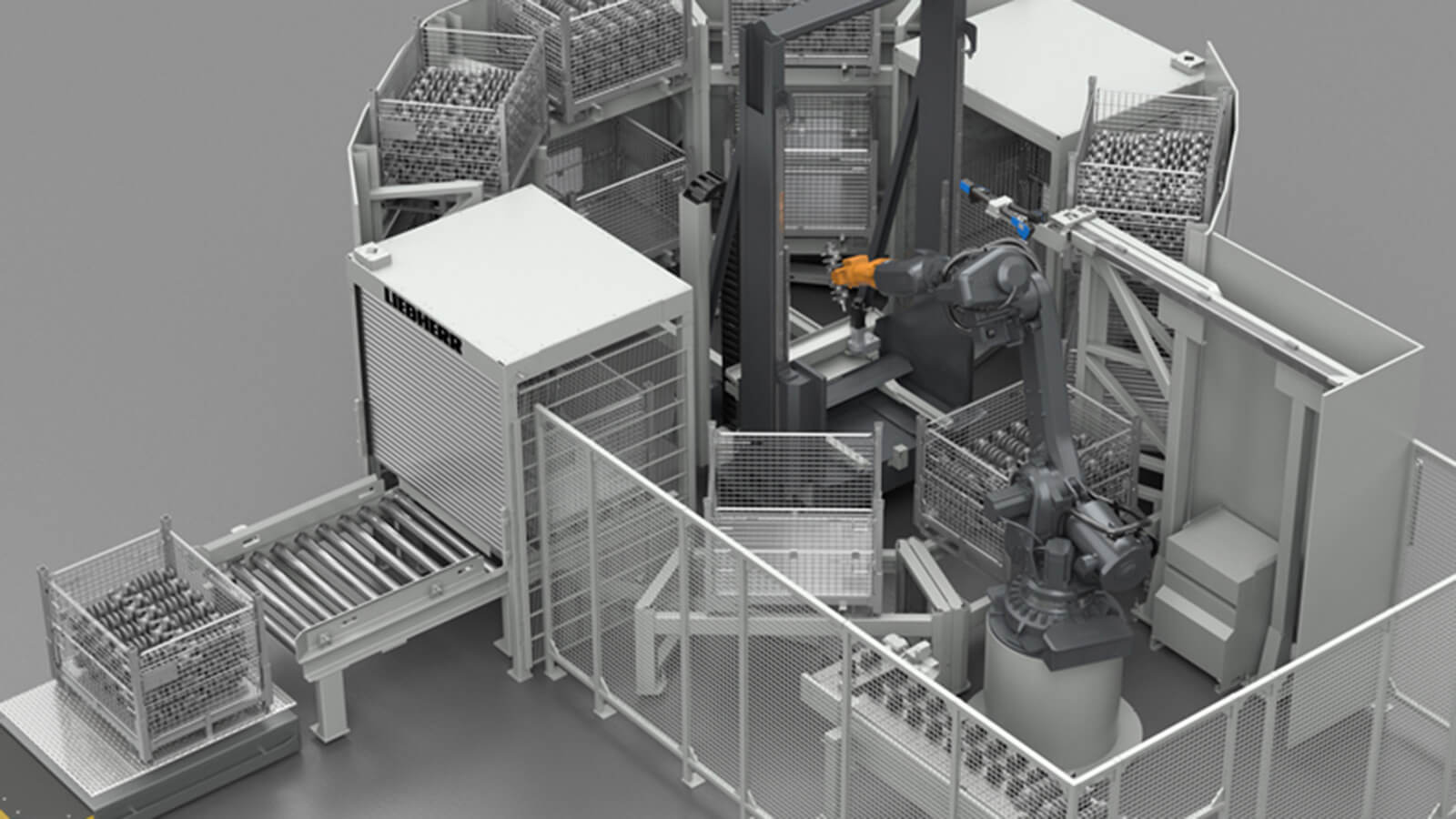You are here
Liebherr Group: Products & Services for Hungary
Other websites for Hungary

Rotary loading systems and bin picking, a robot system also referred to as pick and place, are a permanent feature in the Liebherr automation division. Together, they form a good team in automating inputs and outputs from production lines.
In many modern production facilities, manufacturing lines with numerous machines work through various processing steps in an automated manner. Uwe Radigk, Head of Global Key Account Management in the automation division of Liebherr-Verzahntechnik GmbH, knows that automation often stops at the end of the line: “Loading components on these production lines still often takes place by hand. Blanks are supplied to the bins in chaotic order and positioned for machining by workers. The aim here is to provide sensible automation solutions for the inputs and outputs of these kinds of production lines as well that make the production process easier and more reliable.” The smaller the batch size and the more diverse the components and workpieces that are produced on the line, the more challenging this task becomes.
Liebherr has developed highly flexible intralogistics for a customer in the automotive industry. “In this particular example, a manufacturing line with about 30 machines processes and machines crank shaft blanks of different types from an unfinished to a finished part”, reports Uwe Radigk who supervised the project. “These arrive in random order in bins at the start of the line. Production is not meant to be controlled through complete emptying of each bin, though, rather via the specified number from the customer’s main computer. If only half of the blanks in a bin are required, the remainder is stored for an interim period and processing continues on new bins with different component types.”
The more precise workpiece placement is to be, the more challenging the task is for the vision system, the picking technology and the alignment station.
This problem has been solved by Liebherr using a rotary loading system (RLS) with bin picking. The individual workpieces lie in these bins in chaotic order. The core of the Liebherr bin picking system is an intelligent piece of software that compares data from 3D visualization of the bin contents with the actual CAD data of the workpieces being searched for and detects the correct parts. Potential picking points are determined in the process and a collision-free withdrawal path is calculated. “This means that the robot is capable of picking the optimally positioned workpiece precisely from a depth of up to one metre,” explains Uwe Radigk. Since the components have many different picking positions, an intermediate storage area is used as a re-grip station on which the components can be realigned before transfer to the manufacturing line. With tasks such as these, “the more precise workpiece placement is to be, the more challenging the task is for the vision system, the picking technology and the alignment station. The typical cycle time for this process is roughly 30 seconds.”
This procedure enables a high variance of parts as well as very flexible production. The feed station features a rotary loading system (RLS) with eight storage locations for intermediate storage of the workpiece bins, two workstations, a loading station and an outfeed position. In this way, orders can be worked through in a variable manner. The cell retools itself and checks the workpieces. A special weight sensor detects workpieces that are wedged together. Through a comparison with CAD data, the vision system also detects parts that should not be in the bin and will not pick them. In this way, process reliability is increased due to the fact that an inspection is directly integrated in the logistics process.
Finished machined parts are usually very sensitive. Most components arrive at the commissioning station in batches and are correctly sorted on a conveyor belt, another solution provided by Liebherr. The parts are picked by a robot arm and placed in suitable blisters which, in turn, are stacked in bins. The picking system therefore features two tools equipped with an automatic changeover system. It handles workpieces with a mechanical parallel gripper and blisters with a vacuum gripper.
A pallet handling system (PHS 1500) with a large number of storage positions is capable of receiving full or partially full bins at any time. Once the bins are filled with finished parts, they exit the line automatically on a conveyor and are then picked up again by unmanned tools. At the same time, empty bins with blisters are fed into the system via a second conveyor.
“We were able to successfully bring the system into operation for our customer in March 2019. It is operating reliably and they are very satisfied with their new system,” reports Uwe Radigk from the field. The potential for savings that they had hoped for is already evident. The company is saving material costs and reduces the burden on the environment through the efficient automated process. Staff can focus fully on the productivity of the line because manual loading is no longer necessary. “We have been able to elevate production to a new level while decreasing potential hazards with this system.”